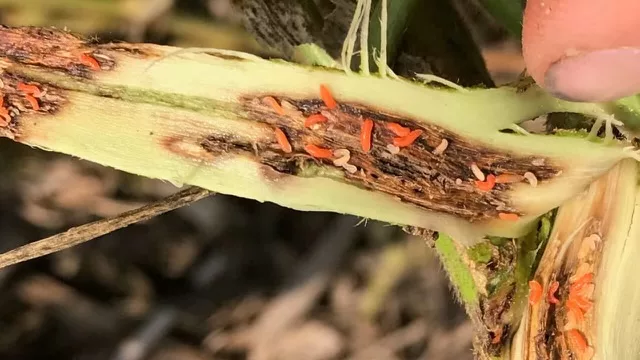
Photo courtesy of Dan Bjorklund
There’s a new crop pest that has recently popped up in Greene County that has everyone baffled.
Landus Cooperative Field Agronomist Dan Bjorklund tells Raccoon Valley Radio the soybean gall midge is a newer pest that flies to soybean plants and lays its eggs at the base. When the eggs hatch, the larvae feed on the inside of the soybean stem and kill off the plant. He says this pest just started showing up in Greene County.
“It’s only in small areas. I haven’t seen anything beyond end rows because these flies are very weak flyers and they go from roadside ditches (and) waterways to the first soybean plant, lay their eggs and they’re done. They haven’t migrated throughout fields but in western parts of the state, where they’ve been there for four or five years and they’ve been moving a little bit further, there are fields that they’ve caused some pretty significant yield loss.”
Bjorklund points out the only signs that people can see from the outside of a soybean plant is at the soil line is a thick brownish/black line that looks like it’s killing the crop. Bjorklund says ISU Extension and Outreach has been studying this pest that was first found in Nebraska in 2015 and is making its way across Iowa now.
“They can’t really trace it to any invasive insect that’s come from somewhere else, like they did soybean aphids. They think this particular adult just decided to start feeding on soybeans, that’s the only thing that they can say. And it just fits with everything else that we do when we’re trying to grow soybeans.”
Bjorklund says this pest has a very identifiable bright orange color in its larvae state and it can inhabit the soil over winter. He adds there are currently no management practices for the gall midge and those that have tried spraying their fields saw little success because they would have to frequently spray every week because the timing of when the pest shows up is unpredictable. Bjorklund notes this pest is currently only found in the end rows and has not attacked an entire field.
Click the link below for information from ISU Extension about the soybean gall midge.
https://crops.extension.iastate.edu/encyclopedia/soybean-gall-midge#:~:text=Adult%3A%20Adu

